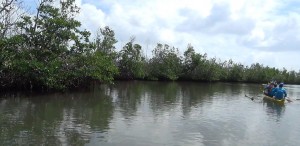Mangroves can serve as protective wall, even against a storm like Yolanda
Video by INQUIRER.net’s Ryan Leagogo
TACLOBAN CITY, Philippines – The tale of two barangays (villages) in the municipality of Giporlos, Eastern Samar is a clear example of how mangroves can protect people from the wrath of a typhoon’s storm surge, even one as strong as Yolanda (international name: Haiyan).
Barangay Parina is nestled comfortably between two large mangrove forests approximately nine hectares in size which served as a protective cover for when Yolanda’s storm surge rushed inland nearly a year ago.
In contrast, Barangay Bacjao (local term for mangrove trees), was located outside of the mangrove area and was completely destroyed when the storm surge rushed in with irresistible force.
Both barangays didn’t suffer casualties; Parina because the storm surge was weak even though they evacuated to inside the school and church, and Bacjao because they evacuated the place entirely knowing that their area was a danger zone.
Kagawad (councilor) Serafin Balais Jr., 26, of Barangay Parina told INQUIRER.net Wednesday that the mangroves absorbed the force of the storm surge so much that all they experienced was the slow and gentle rise of water.
“The rush of the water was not powerful, it just streamed in and also receded slowly for a duration of about five to 10 minutes,” Balais said in Filipino. “In Bacjao where they didn’t have any mangroves, all the houses were destroyed, even the foundations.”
“Most of the houses were made of light materials and were blown away by Yolanda’s winds. Around 25 houses remained but were partially damaged,” he said.
The Mangrove forests, however, paid the price for standing up to Yolanda. Balais said that only 30 percent of the forest remained intact after facing the strongest typhoon to ever make landfall.
“We are now replanting the forest because it will serve as our protector when future typhoons come,” Balais said. “Mangroves are not uprooted easily, their roots are many and deep which make them really suitable as shield against waves.”
The mangrove replanting is part of Plan International’s cash for work program where local residents are the beneficiaries.
“The Barangay Council already has plans to protect the mangroves because they are not just a good defense for us but also for the future generations. We hope to expand the forest and maintain it. We already have ordinances to outlaw the cutting of mangroves,” Balais said.
Balais told of stories from older generations that the very ground where their barangay stood was once also part of the Mangrove forest.
Because they have personally experienced the protection of the mangroves, Balais said that they do not hesitate to advocate their importance to other local governments.
“Anybody who comes into our barangay, we always tell them what a big help the mangroves have been for us,” Balais said.















